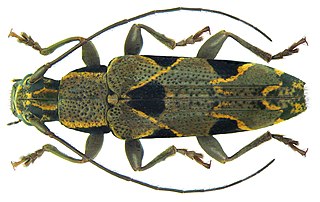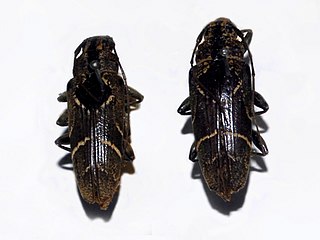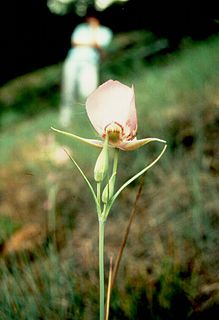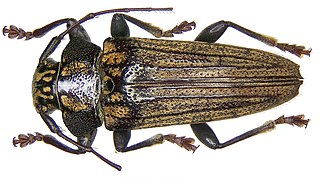
The green warbler, also known as green willow warbler or green leaf warbler, is a leaf warbler found in the Caucasus Mountains in southcentral Europe.

Emmelichthys nitidus is a species of rover native to the Indian and Pacific oceans at depths of between 86 to 500 metres. There are currently two subspecies known:

Cryptocephalus is a genus of leaf beetles in the subfamily Cryptocephalinae and belonging to the group of case-bearing leaf beetles called the Camptosomata.

Euryoryzomys emmonsae, also known as Emmons' rice rat or Emmons' oryzomys, is a rodent from the Amazon rainforest of Brazil in the genus Euryoryzomys of the family Cricetidae. Initially misidentified as E. macconnelli or E. nitidus, it was formally described in 1998. A rainforest species, it may be scansorial, climbing but also spending time on the ground. It lives only in a limited area south of the Amazon River in the state of Pará, a distribution that is apparently unique among the muroid rodents of the region.

Euryoryzomys nitidus, also known as the elegant oryzomys or elegant rice rat, is a rodent species in the family Cricetidae. Previously it was known as Oryzomys nitidus, but it is not closely related to Oryzomys as that genus is now constructed. Its range includes Bolivia, Brazil and Peru to the east of the Andes, in lowland tropical rainforest as well as forest in the eastern foothills of the mountains, at elevations from 50 to 2,000 m.

Zonitoides nitidus is a species of small, air-breathing land snail, a terrestrial pulmonate gastropod mollusk in the family Gastrodontidae.

The Himalayan field rat, sometimes known as the white-footed Indo-Chinese rat, is a species of rodent in the family Muridae. It has a wide range, being found in India, Bangladesh, Nepal, Bhutan, China, Myanmar, Laos, Thailand, and Vietnam, with introduced populations in Indonesia (widely), Palau, and the Philippines. A common species, the International Union for Conservation of Nature has assessed its conservation status as being of "least concern".
Limnonectes nitidus is a species of frog in the family Dicroglossidae. It is endemic to Peninsular Malaysia where it is only known from the Cameron Highlands and Fraser's Hill, both in Pahang state.

Lichen nitidus is a chronic inflammatory disease of unknown cause characterized by 1–2 mm, discrete and uniform, shiny, flat-topped, pale flesh-colored or reddish-brown papules that may appear as hypopigmented against dark skin. Occasionally, minimal scaling is present or can be induced by rubbing the surface of the papules. The disease usually affects children and young adults and is painless and usually nonpruritic, although protracted itching may occur in some cases. It is sometimes referred to by dermatologists as "mini lichen planus".
Nitida, Nitidum and Nitidus are forms of the Latin for "bright, shining, sleek, blooming, smart" and may refer to:

Petalonyx nitidus is a species of flowering plant in the family Loasaceae known by the common name shinyleaf sandpaper plant. It is native to the deserts and desert mountains of the southwestern United States, where it grows in scrub, woodland, and other habitat. It is a clumpy subshrub made up of many rough-haired, erect or spreading stems growing 15 to 45 centimeters long. The leaves are oval, pointed, usually toothed or serrated, and up to 4 centimeters long. The inflorescence at the end of the stem is a crowded raceme of many flowers. The flower appears tubular, its white petals fused near the spreading tips but open lower, the long stamens extending well beyond the corolla, and unusual in that they emerge from outside the corolla.
Copelatus nitidus is a species of diving beetle. It is part of the genus Copelatus in the subfamily Copelatinae of the family Dytiscidae. It was described by Sharp in 1882.

Tmesisternini is a tribe of beetles in the subfamily Lamiinae containing the following genera:

Tmesisternus is a genus of longhorn beetles belonging to the family Cerambycidae, subfamily Lamiinae.

Calochortus nitidus, the broadfruit mariposa lily, is a North American species of flowering plants in the lily family native to the northwestern United States.

Tmesisternus distinctus is a species of beetle in the family Cerambycidae. It was described by Jean Baptiste Boisduval in 1835.
Tmesisternus dubius is a species of beetle in the family Cerambycidae. It was described by Xavier Montrouzier in 1855.
Tmesisternus jaspideus is a species of beetle in the family Cerambycidae. It was described by Jean Baptiste Boisduval in 1835.
Tmesisternus schaumii is a species of beetle in the family Cerambycidae. It was described by Francis Polkinghorne Pascoe in 1867. It is known from Moluccas, Australia, and the Solomon Islands.

Tmesisternus venatus is a species of beetle in the family Cerambycidae. It was described by James Thomson in 1864.












